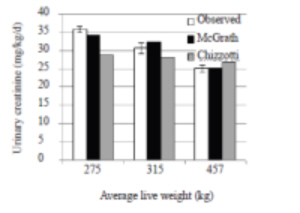



A Urine Creatinine Excretion Model For Beef Steers
Researchers from the University of New England have developed a more efficient model to predict creatinine excretion from lightweight beef steers, to help assess their metabolic state.Metabolism studies often require collection of urine for accurate determination of excreted products.
Total collection of urine over a period of 24 hours or more can be stressful to the animal and is often impractical, especially in grazing situations and when large numbers of animals are involved.
Urine spot-sampling, while not as accurate as total collection of urine, can be useful for assessing the metabolic state of an animal if total daily urine output can be calculated.
Creatinine is a waste product of muscle turnover and the creatinine concentration of urine spot-samples has been used to estimate daily urine excretion. Several workers have used this approach to compare mineral excretion in periparturient dairy cows (e.g., Goff and Horst, 1998). Chizzotti et al. (2008) measured creatinine excretion rates using Holstein heifers of various live weights and derived the equation, CE (mg/kg) = (0.28 – 0.000097 × LW) × 113.18, where CE is creatinine excretion per 24 h, LW is live weight of the animal in kg and 113.18 is the molecular weight of creatinine.
They found that creatinine excretion rate decreased as body weight increased and as animals aged. Thus, it may be possible to use a standard creatinine production rate (per kg live weight) for mature animals.
Three data sets obtained from successive metabolism studies at the University of New England were evaluated with the aim of producing a model for the calculation of daily creatinine excretion in beef steers. Rumen fistulated Angus × Brahman beef steers (n = 19, ca. 25 per cent Bos indicus content) were housed in metabolism crates for up to five consecutive days.
Over a 12-month period, the steers were used in three experiments that each involved total collection of urine. The steers were approximately 15 months old (mean live weight, 275 kg) at the start of the first experiment and 28 months old (mean live weight 457 kg) at the start of the last experiment.
Urine samples were analysed for creatinine level using an auto-analyser (Dade Behring Dimension RXL Clinical Chemistry System, Newark, DE). Data from the three experiments were pooled and analysed for the effect of treatment.
The results were described by the linear regression y = –0.05x + 48.14 (R2 = 0.398), where y is urine creatinine excretion (mg/kg.day one and x is liveweight (kg). There were no treatment effects on urine creatinine production in the respective experiments.

Figure 1 shows that the formula created using data from our experiments provides better predictions at lower live weights than the formula of Chizzotti et al. (2008).
The difference between the two calculated creatinine excretion rates decreased as the animals matured. The formula for creatinine excretion presented here will more accurately predict creatinine excretion from lightweight beef steers.


